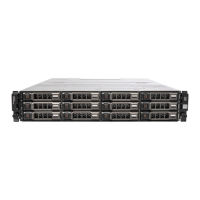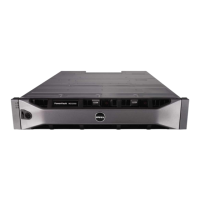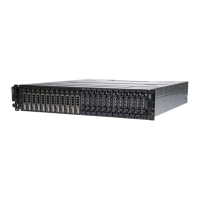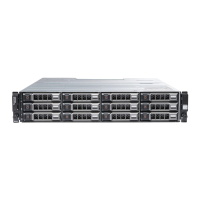Configuration: Disk Groups and Virtual Disks 127
Mappings area. If additional mappings are defined for one of these
Unidentified Mappings, the
Define Additional Mapping
dialog shows the
LUN list, and the
Add
button is unavailable.
• Do not configure dual mappings on a Windows host.
• If there is a host with a restricted host type that is part of a specific storage
partition, all of the hosts in that storage partition are limited to the
maximum number of LUNs allowed by the restricted host type.
• You cannot move a host with a restricted host type into a storage partition
that already has LUNs mapped that are greater than what is allowed by the
restricted host type. For example, if you have a restricted host type that
allows only LUNs up to 31, you cannot move that restricted host type into
a storage partition that has LUNs greater than 31 already mapped.
The Default Group on the Mappings tab has a default host type. You can
change this type by selecting Storage Array Change Default Host Type.
If you set the default host type to a host type that is restricted, the maximum
number of LUNs that are allowed in the Default Group for any host are
restricted to the limit imposed by the restricted host type. If a particular host
with a non-restricted host type becomes part of a specific storage partition,
you can change the mapping to a higher LUN.
Changing the RAID Controller Module Ownership of a Virtual Disk or a
Disk Group
You can change the RAID controller module ownership of a virtual disk or a
disk group.
You can change the RAID controller module ownership of a standard virtual
disk or a snapshot repository virtual disk. You cannot directly change the
RAID controller module ownership of a snapshot virtual disk because the
snapshot virtual disk inherits the RAID controller module owner of its
associated source virtual disk. Changing the RAID controller module
ownership of a virtual disk changes the preferred RAID controller module
ownership of the virtual disk.
During a virtual disk copy, the same RAID controller module must own both
the source virtual disk and the target virtual disk. Sometimes both virtual
disks do not have the same preferred RAID controller module when the
virtual disk copy starts. Therefore, the ownership of the target virtual disk is
automatically transferred to the preferred RAID controller module of the
book.book Page 127 Tuesday, September 27, 2011 3:25 PM

